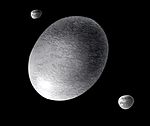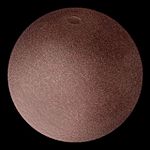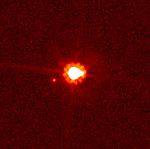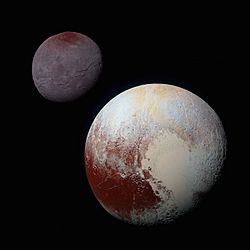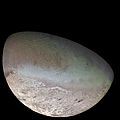Dwarf planet facts for kids
Dwarf planet is the name used to classify some objects in the solar system. According to the definition proposed by the International Astronomical Union (IAU) on August 24, 2006, a dwarf planet can be described as a body orbiting the Sun that is big enough to round itself by its own gravity, but has not cleared its orbital path of other rival bodies.
The term dwarf planet was coined by planetary scientist Alan Stern as part of a three-way categorization of planetary-mass objects in the Solar System: classical planets, dwarf planets and satellite planets. While Stern and other planetary geologists consider dwarf planets and satellite planets to be planets, the IAU and perhaps the majority of astronomers have excluded them from the roster of planets.
History of the concept
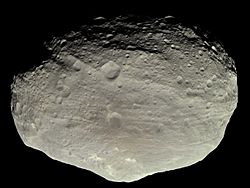
Starting in 1801, astronomers discovered Ceres and other bodies between Mars and Jupiter that for decades were considered to be planets. Between then and around 1851, when the number of planets had reached 23, astronomers started using the word asteroid for the smaller bodies and began to distinguish them as minor planets rather than major planets.
With the discovery of Pluto in 1930, most astronomers considered the Solar System to have nine major planets, along with thousands of significantly smaller bodies (asteroids and comets). For almost 50 years Pluto was thought to be larger than Mercury, but with the discovery in 1978 of Pluto's moon Charon, it became possible to measure Pluto's mass accurately and to determine that it was much smaller than initial estimates. It was roughly one-twentieth the mass of Mercury, which made Pluto by far the smallest planet. Although it was still more than ten times as massive as the largest object in the asteroid belt, Ceres, it had only one-fifth the mass of Earth's Moon. Furthermore, having some unusual characteristics, such as large orbital eccentricity and a high orbital inclination, it became evident that it was a different kind of body from any of the other planets.
In the 1990s, astronomers began to find objects in the same region of space as Pluto (now known as the Kuiper belt), and some even farther away. Many of these shared several of Pluto's key orbital characteristics, and Pluto started being seen as the largest member of a new class of objects, the plutinos. It became clear that either the larger of these bodies would also have to be classified as planets, or Pluto would have to be reclassified, much as Ceres had been reclassified after the discovery of additional asteroids. This led some astronomers to stop referring to Pluto as a planet. Several terms, including subplanet and planetoid, started to be used for the bodies now known as dwarf planets. Astronomers were also confident that more objects as large as Pluto would be discovered, and the number of planets would start growing quickly if Pluto were to remain classified as a planet.
Eris (then known as 2003 UB313) was discovered in January 2005; it was thought to be slightly larger than Pluto, and some reports informally referred to it as the tenth planet. As a consequence, the issue became a matter of intense debate during the IAU General Assembly in August 2006. The IAU's initial draft proposal included Charon, Eris, and Ceres in the list of planets. After many astronomers objected to this proposal, an alternative was drawn up by the Uruguayan astronomers Julio Ángel Fernández and Gonzalo Tancredi: they proposed an intermediate category for objects large enough to be round but which had not cleared their orbits of planetesimals. Beside dropping Charon from the list, the new proposal also removed Pluto, Ceres, and Eris, because they have not cleared their orbits.
Although concerns were raised about the classification of planets orbiting other stars, the issue was not resolved; it was proposed instead to decide this only when dwarf-planet-size objects start to be observed.
In the immediate aftermath of the IAU definition of dwarf planet, some scientists expressed their disagreement with the IAU resolution. Campaigns included car bumper stickers and T-shirts. Mike Brown (the discoverer of Eris) agrees with the reduction of the number of planets to eight.
NASA announced in 2006 that it would use the new guidelines established by the IAU. Alan Stern, the director of NASA's mission to Pluto, rejects the current IAU definition of planet, both in terms of defining dwarf planets as something other than a type of planet, and in using orbital characteristics (rather than intrinsic characteristics) of objects to define them as dwarf planets. Thus, in 2011, he still referred to Pluto as a planet, and accepted other likely dwarf planets such as Ceres and Eris, as well as the larger moons, as additional planets. Several years before the IAU definition, he used orbital characteristics to separate "überplanets" (the dominant eight) from "unterplanets" (the dwarf planets), considering both types "planets".
As there is no clear definition of what constitutes a dwarf planet, the number of dwarf planets in the Solar System is unknown.
Exploration
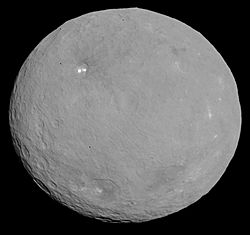
On March 6, 2015, the Dawn spacecraft entered orbit around Ceres, becoming the first spacecraft to visit a dwarf planet. On July 14, 2015, the New Horizons space probe flew by Pluto and its five moons.
Ceres displays such evidence of an active geology as salt deposits and cryovolcanos, while Pluto has water-ice mountains drifting in nitrogen-ice glaciers, as well as a significant atmosphere. Ceres evidently has brine percolating through its subsurface, while there is evidence that Pluto has an actual subsurface ocean.
Dawn had previously orbited the asteroid Vesta. Saturn's moon Phoebe has been imaged by Cassini and before that by Voyager 2, which also encountered Neptune's moon Triton. All three bodies show evidence of once being dwarf planets, and their exploration helps clarify the evolution of dwarf planets.
New Horizons captured some distant images of Quaoar in 2016, from 2.1 billion km away (1.3 billion mi; 14 AU).
Discovery
- Ceres was found by Giuseppe Piazzi on January 1, 1801. Classified as a dwarf planet on September 13, 2006.
- Pluto was found by Clyde W. Tombaugh on February 18, 1930. Reclassified as a dwarf planet on August 24, 2006
- Haumea was found by a team led by Mike Brown on December 28, 2004. Accepted as a dwarf planet on September 17, 2008.
- Makemake was found by a team led by Mike Brown on March 31, 2005. Accepted as a dwarf planet on July 11, 2008.
- Eris was found by Mike Brown and his science team on January 5, 2005. Accepted as a dwarf planet on September 13, 2006.
Images for kids
See also
 In Spanish: Planeta enano para niños
In Spanish: Planeta enano para niños



